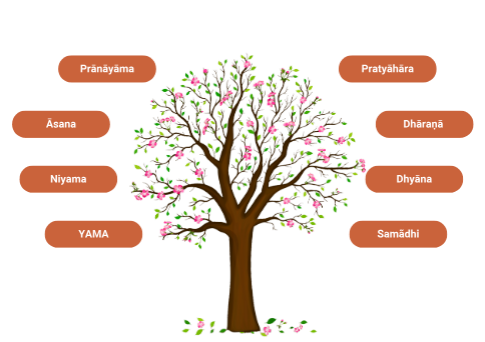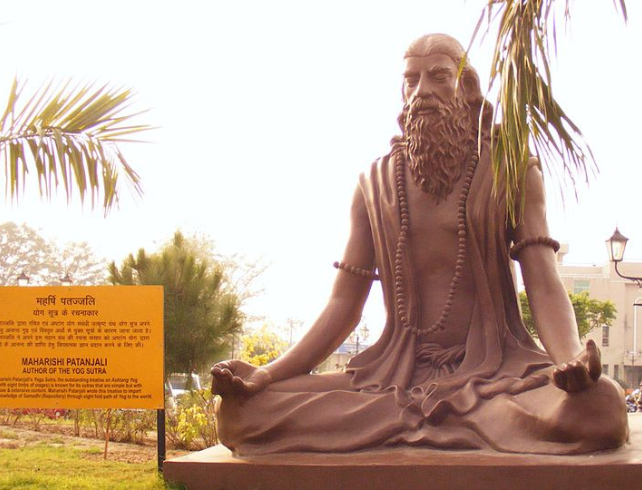As we learn to get in touch with our breath – our prana, our life
force – we come into contact with the very divine force, which sustains
our existence and unites us with the rest of the world. Prana literally
means the life force, the energy, which fl ows through all. It can be
physical energy, mental energy, intellectual energy or even magneƟ c
or heat energy! Prana means “life” and Ayama means expansion, so
Pranayama means expansion of life. Pranayama is the extension, the
stretching, the prolonging of our life force and energy. Pranayama
teaches us to be calm, collected and centered. As the breath becomes
sƟ ll, slow, deep and steady, we fi nd that in our lives also we become
steady and sƟ ll. We learn not to be ruffl ed by the ups and downs of life.
We feel deeply connected to the very force that fl ows through each of
us, giving us life. We must purify our lives by ensuring that our acƟ ons
are models of integrity, dharma and righteousness.
After Pranayama, is Pratyahara, which is the withdrawal of the senses. In life, we are aware of so many things, all that we see, hear, smell, touch and taste. In fact, we are flooded with sensory perceptions, so much that we frequently feel overloaded. “I need some quiet. I feel claustrophobic. I have a headache. I need to be alone. The world seems to be spinning.” These are all examples of sensory overload. The more we are focused on outward awareness, the less time and energy we have to be focused on internal awareness. Pratyahara is like taking the millions of antennae all over our body (absornig nature in to us through our senses) and turning them from outward to inwards; a total and complete withdrawal of all the senses, of all organs of perception. It is important to realize that Pratyahara is not a dulling of the senses. Rather it is simply turning the object of our senses from the external to the internal. Thus, with the same keen awareness that we perceive the outside world, we are able to perceive the internal world. This is single-minded concentration. Pranayama teaches us to control the breath. Pratyahara teaches us to control the senses.
Dharana teaches us to control the mind. In Dharana, there are a wide variety of objects of concentration one can use. A burning candle, an image of the Divine, the ocean, the tip of one’s own nose, the center between one’s eyebrows, the sound of a mantra, these are all common objects. The point is to focus, to stop the incessant wanderings of the mind, to channel all thought power in one direction, and to teach us to be the masters of our own minds. We have added some religious images, and signs of different religions that a yogi can concentrate on during his meditation session, and also can lengthen the chanting of Om, Ek unkar, Jesus, or Allah Hu Akbar. Usually our minds are the masters and we are the slaves. Our minds are filled with anger, jealousy, lust, greed, fear, desire, and we run around like servants answering every beck and call of the fickle mind. Through Dharana, and then even more through Dhyana, we learn that we are the masters and the mind is the slave. Many people think that on a spiritual path one has to “overcome one’s mind.” This is not true. The mind is a wonderful thing. The mind, in many ways, is what makes us human rather than an animal. It allows us to think, to plan, to have compassion, to create. But the problem comes when the mind becomes Master or in charge. The mind should be a tool, just like the tongue is a tool. The tongue helps us to eat, and thereby keeps us alive. But one would never turn over the control to our tongue. Mind should not be allowed to go wherever is wants, do whatever it chooses and control the whole show. Dharana helps teach us that we are in charge. We are the boss. The mind is only a tool.
The last step before Samadhi is Dhyana, meditation. “Meditation is the best medication for all agitations.” People frequently confuse concentration with meditation. They confuse Dharana with Dhyana. In concentration there is a subject and an object. You, the subject, are concentrating on a candle, or an image of God, or the tip of your nose or signs and symbols as shown in this book. These are the object of your concentration. In meditation, the object disappears. The subject disappears. All becomes one. In meditation, all borders, boundaries, and separation between the Universe and us begin to disappear. We begin to realize the inherent oneness of all beings and all creation. There is a famous mantra that says, “So Hum.” It means: “I am that. I am one with the universal energy. I am part and parcel of all that exists. I am one with God.” Through meditation, we catch a glimpse of that realization. Meditation gets us back in touch with our true, divine nature and the deepest core of our being. There is so much that has been written and taught on meditation and its different techniques by old yoga masters religious leaders, yoga pundits, sages, saints and yoga practitioners of different customs, cultures, religious experts of different field. The important thing is that it is not so important which technique you use. While, I personally use Tratak and Trinetrika and Chant Yam, Rum, Lum, Vum, Onkar or Aum, each of us is different. We all have different temperaments, different sensibilities. Therefore, different techniques will work for different people. There is no right or wrong way to meditate.
Last is Samadhi, the Divine Union, ecstasy, bliss. Samadhi literally means to merge, to come together. Here, the subject is completely lost. The object is completely lost. There are no boundaries. No barriers. No separation. The lover and the beloved, become one like Shakti and Deva, or Shiva the Lord of yoga; even in Havana kund, yoni is represented as Shakti who accepts the Auhitis offered in Agni of yoga. Every cell of our being becomes saturated with God. We are no longer looking for Him or praying to Him. Rather, we merge into Him like the rain drop merges into the ocean. All identity is lost. We are one with the Source of energy, almighty the God. Sometimes people think Samadhi means trance, a time in which all sense is lost and one becomes so immersed in the Divine that one loses all awareness of the outside world. This is also a definition of Samadhi, but it is not only in a trance. One cannot live in a trance. The question is how to attain a state of Samadhi that is with you all of the time. Divine trance is beautiful; it is wonderful. But I want you to have more than that. To practice and attain the higher goal of yoga mediation. I want you to attain a Samadhi that exists even when your eyes are open, when you’re moving in the world. And that is possible.
When we attain Samadhi our lives become peaceful, joyful, problem free. Obstacles still come, but they do not affect us from attaining the blessing of Samadhi or peak of meditation. Ups and downs are there in life, but we do not go up and down. Samadhi is the divine shock absorber. No matter how rough the roads of life may be, we are smooth and shock-free. Samadhi means that we have the reins of our lives only in our own hands; other people cannot switch us on and off like light bulbs. We know that we are one with God and that oneness fills us with such peace, such bliss, and such stability that nothing else can affect us. Samadhi means, essentially, that our lives are lived in peace, not in pieces, and that is the ultimate goal of yoga, Divine Union. I pray that you may all walk the divine path of yoga with strength, courage and steadfastness, and that you may all stay committed to the goal. I pray that through the practice of the eight limbs with devotion and perseverance, the grace of Samadhi may be showered upon the readers of this yoga book. Then, you will not only experience the path of yoga in a yoga class, but your life itself will become a path of yoga. Pranayama is the extension, the stretching, the prolonging of our life force and energy.


